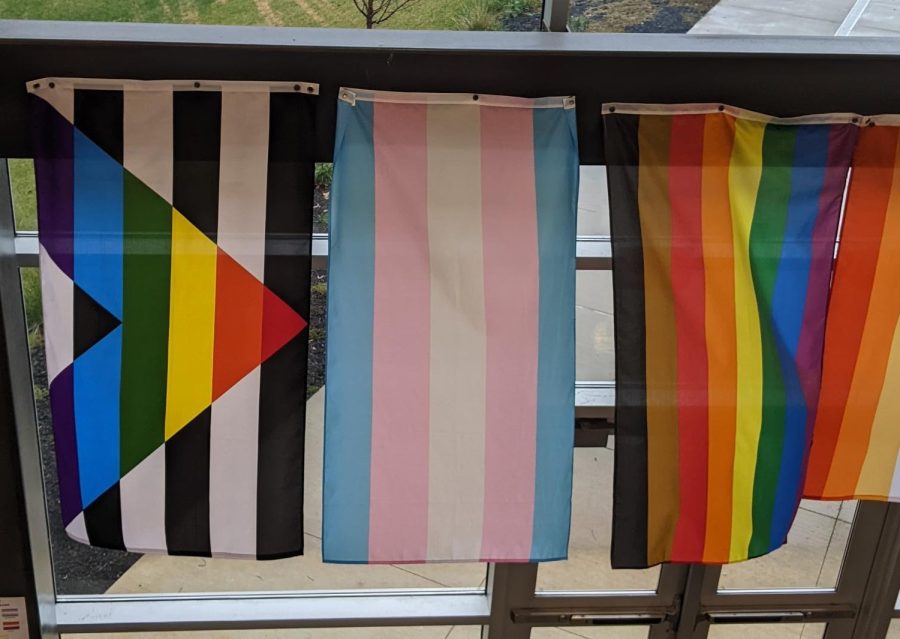Transgender Awareness Month
The pride, transgender, and ally flag (top to bottom) hanging together at State High.
November 22, 2022
November is Transgender Awareness Month, a month to both educate others on the trans identity and celebrate the voices and experiences that transgender people have. It is an important month that plays a large part in destigmatizing and breaking the harmful stereotypes that surround transness.
Along with Transgender Awareness month, there is also a week that is dedicated to raising awareness for Transgender people. This year, Transgender Awareness Week will run from November 13 – 19. This week allows a specialized time for donations to charities that support transgender people like funding medical transitions and assisting trans youth.
Transgender Day of Remembrance was established in 1999 by Gwendolyn Ann Smith, and was created to honor the memory of transgender people who have lost their lives due to harassment, murder, and suicide. This day – set to be celebrated Nov. 20 –is another day to celebrate the lives that were lost and continue the fight for equal rights.
Mackie Shark, a transgender 9th grader at State High, believes that in order for transgender people to discover their gender identity, and be their true self, society must accept trans people by raising awareness. “From my experiences, I feel [that] if you raise more awareness about transgender people, then more people who are trans and even younger kids would be able to explore that about themselves and know that about themselves much earlier,” Shark said.
Today, there are those who do not accept transgender people, and those who do. Today, being transgender is not a crime. However, when the first few transgender people came out about their gender identity, they were discriminated against, not given the very right to be who they are.
The Transgender Rights Movement reaches back to the 20th century, and has largely been an uphill climb. From the 1959 Cooper’s Donut Riots – a response to harassment of a cafe that supported transgender communities – to the 1969 Stonewall Riots for LGBTQ rights. The fight for equal rights has been tiring and extensive. Throughout history, transgender people have time and time again been silenced and discriminated against.
“There are still people who think it’s like a mental illness. But, it’s definitely a lot better than it was a while ago. […] A lot more people were not okay with that and were banned from bars, and banned from other surfaces just because they were trans, and now it’s a lot more widely accepted than it was,” Shark states.
Though transgender people are more accepted in today’s society, there are also stereotypes trans people have had to live with.
Cyril Haque is a transgender freshman at State High. He reflected on his experiences with stereotypes, and recalled transphobia in film culture. “There’s this trope called traps where it’s like boys pretending to be girls in order to trick other characters in a show. I find that really harmful because I feel like a lot of the time it’s meant to reflect on trans people sort of pretending to be a gender that they aren’t. […] That’s really harmful to trans people as a whole because it’s not pretending, it’s who you are,” he voiced.
Stereotypes can be small details people would often overlook, or blatant lies crafted from one trail of misinformation to another.
‘Girl clothes’ and ‘boy clothes’ are two large examples of gender stereotypes in history, and are also incredibly harmful to those who do not fit into the norms as society has cast them. Because there are so many people who are not educated on transness, gender stereotypes create a lot of confusion, which may lead to harmful questioning and judgement.
Maddie Titus, 9th grade counselor at State High, observed this issue and stated that even if those who are merely curious do not mean harm to anyone it can still happen because of natural human curiosity. “Especially in high school, we talk all the time. Constantly ‘oh did you notice this, did you notice this.’ Sometimes it’s intentionally to be mean, sometimes not, because we’re curious people.’” she stated.
The gender stereotypes that are cast onto society can also be directly correlated to gender expression. Lines have been naturally drawn based on this, and on sexism, throughout society.
Gender identity and expression are exactly what they sound like; the gender one identifies as, and how one expresses their gender identity. This can be through fashion, behavior, and physical appearance, among others. Gender identity does not always align with gender expression. Assuming that they always align is harmful to non-binary, transgender, and intersex people, as well as others that do not fall into woman and man.
Ms. Titus shared her thoughts on similar issues and commented, “We’re bred socially to observe and see [that] if someone’s dressed as a female, they’re a female. That’s not always the case now. Males can dress as females, females can dress as males. There’s a difference between gender expression and gender identity, and that’s a thing I think that we should be better educated on, because we shouldn’t assume anyone’s gender based on what they’re wearing.”
Many assume that the terms transgender and transsexual are the same. They are actually quite different from each other and when used interchangeably, they can be harmful towards transgender people.
“[It’s] a very important distinction, because transgender they’re not mutually exclusive but not mutually inclusive. Like for example transgender, you’re just identifying with a gender that isn’t the one assigned to you at birth, whereas transexual is more about like body structure and genitalia and things like that,” Haque attests.
Using transsexual and transgender interchangeably implies that all transgender people seek medical treatment, when transgender people may not feel the need or want to medically transition.
Transgender people, especially youth, often already experience gender dysphoria, a state of unease felt when one’s gender identity does not align with their birth sex, and/or body dysmorphia, a condition where someone has a distorted view of their body, and physical imperfections are often enlarged. To avoid further estrangement and alienation, it is important to know the difference between transgender and transsexual.
It’s statistically proven that transgender youth are more likely to have thoughts of suicide or attempt suicide than adults. According to the National Library of Medicine, 89% of transgenders have experienced thoughts of suicide, 40% have attempted suicide, and a significant amount of those percentages are transgender youth.
“It’s really important to protect trans youth, to keep all of this sort of stigma and mental health negative effects out or prevented. […] Things to avoid are using terms like pretending or saying that someone is the gender they were assigned at birth. Basically absolute terms that sort of confine people into one box,” Haque expressed.
To add to that, there are issues like deadnaming and misgendering. Deadnaming is when someone uses a transgender person’s birth name after they have transitioned and changed their name to align with their gender identity. Misgendering is the same, but rather using words like pronouns that do not align with their gender identity. Note that using someone birth name and birth pronouns in the presence of someone they have not come out to yet is different. Make sure to ask transgender people their pronouns and boundaries.
“As we know, high school, or these 4 years, is the time where you really learn more about yourself, who you’re becoming and who you wanna be, and you can feel stigma from peers, from even professionals I’m sure,” shares Ms Titus. “And that can also hinder the process of coming out, transitioning, etcetera, etcetera.”
Though the fight for transgender rights, and normalization of transgender people was and still is difficult and long-lasting, victories and milestones have been scattered about throughout history.
The first hormone treatment (1939) and gender-affirming surgery (1942) was performed on Michael Dillon, who registered legally in 1944. The first American to medically change sex (1954) was Christine Jorgensen, who also became a transgender rights activist. In 1975, Minneapolis passed laws forbidding discrimination against transgender people, and became the first ever city to create transgender-protection laws. Minnesota then became the first state to grant laws protecting transgender people in 1993. Many more milestones have occurred afterwards, gaining momentum with the Transgender Rights Movement, and the society today welcomes transgender people much more openly. Information found from the New York Times and the Legacy Project Chicago.
As we celebrate transgender people’s voices through Transgender Awareness Month, take a moment to educate yourself on transgender issues, and stereotypes. Understand the importance of knowing and recognizing what you should and should not do when talking about or talking to transgender people.
For more information surrounding the transgender community, click here. For more information about gender identity, expression, and other LGBTQIA+ terms, click here. To learn how to support LGBTQIA+ youth, and prevent mental health illness’ and/or suicide, click here.












